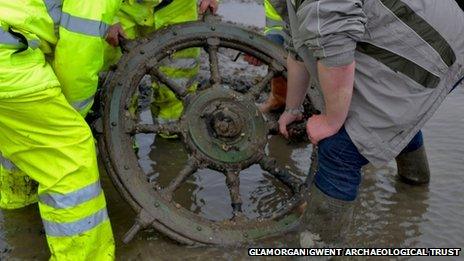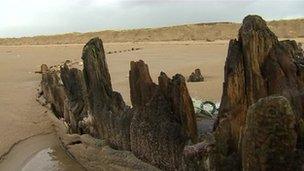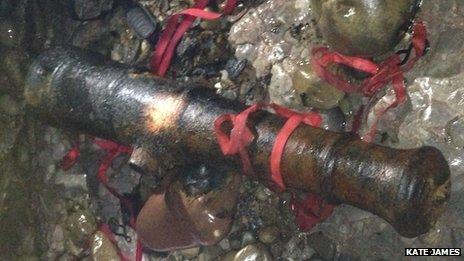Ship's wheel uncovered in Swansea Bay after storms
- Published

The ship's wheel was found by volunteers looking for items after the recent storms
A ship's wheel which may date back to the 19th Century has been uncovered in Swansea Bay following recent storms.
A member of a heritage group found the wheel while exploring sands near Mumbles at the weekend.
Once the wheel has been cleaned, experts said it might have the name of the ship it belonged to on it, or a serial number to identify it.
The wheel will go through a preserving process for the next few years and then hopefully be displayed in the city.
Paul Huckfield from Arfordir Coastal Heritage project said he had sent messages out to groups along the coast following the storms to be watchful for uncovered artefacts.
Heritage

Two shipwrecks were uncovered on Cefn Sidan beach in Carmarthenshire
"It's been a double-edged sword. Some sites have been destroyed and some new ones exposed," he told BBC News.
"Because we're about to come up to another high tide this weekend, in order to recover the wheel we decided to get it out now.
"It's a tangible link to the heritage of the area and we don't want it to be lost again."
He believes the wheel could date from anywhere between the late 1800s and the 1940s.
It is possible it could be part of a ship which has sunk off the coast of south Wales.
"That section of coastline has a large number of wrecks so it may have come from one of those," Mr Huckfield said.
The wheel will be placed in a tank containing salt water at the Glamorgan-Gwent Archaeological Trust offices, which runs the heritage project.
Over the next three or four years, the water will slowly be replaced by clean water to draw the salt out of the wood in order to be able to preserve it for the future.
Then it is hoped the wheel will go on display at a museum in the city.
Cannon
The recent storms have led to a rash of discoveries along the Welsh coast.
Two ships were exposed on Cefn Sidan beach near Kidwelly in Carmarthenshire along with the remains of petrified forest further west in Newgale, Pembrokeshire.
Two ship's cannon came to light in Porthcawl, Bridgend county, which are believed to date from Georgian times.
Mr Huckfield said further investigations on Pink Bay in Porthcawl had revealed a load of timber on the beach.
"We think that could be the wreck the cannon came from," he added.
Members of the Kenfig heritage group are now doing research on the cannon's origins along with Porthcawl museum.
In addition to the two finds, a further wreck on Kenfig beach which was last exposed in the 1980s has been uncovered.
Both the Kenfig and Llanelli wrecks would remain in situ, Mr Huckfield added.

The cannon found in Porthcawl may be Georgian in origin
- Published13 January 2014
- Published13 January 2014
- Published9 January 2014
- Published23 January 2014